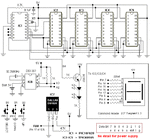Damnthistinleg
Newbie level 3
Hello, this is my first post here so please go easy on me. Although I have a bit of knowledge, it's more space than mark - if you see what I mean!
Anyway, I'm working on a little project for which the MAX7219 is almost ideal. I need to drive 8 large seven segment displays but they require more power than is available directly from the 7219.
Although no datasheet is available for the displays, each segment appears to use four high-brightness LEDS in series with a 100 ohm current limiting resistor. I suspect from this that they are intended to be driven by 12 volts DC. I would like to take advantage of the PWM dimming facility on the MAX7219 so I need to do two things. Firstly, I reckon I'll need to drop the resistor value to around 27 ohms to increase the current through the LEDs, as they will now be pulsed. Secondly, I'll need to amplify the output from the 7219 in order to provide the appropriate voltage and current.
The problem is that I need to do this as efficiently as possible as I want to run everything from a 12 volt battery.
Many thanks in advance for any help!
Dave.
Anyway, I'm working on a little project for which the MAX7219 is almost ideal. I need to drive 8 large seven segment displays but they require more power than is available directly from the 7219.
Although no datasheet is available for the displays, each segment appears to use four high-brightness LEDS in series with a 100 ohm current limiting resistor. I suspect from this that they are intended to be driven by 12 volts DC. I would like to take advantage of the PWM dimming facility on the MAX7219 so I need to do two things. Firstly, I reckon I'll need to drop the resistor value to around 27 ohms to increase the current through the LEDs, as they will now be pulsed. Secondly, I'll need to amplify the output from the 7219 in order to provide the appropriate voltage and current.
The problem is that I need to do this as efficiently as possible as I want to run everything from a 12 volt battery.
Many thanks in advance for any help!
Dave.
